First Person
For the Love of Stripes
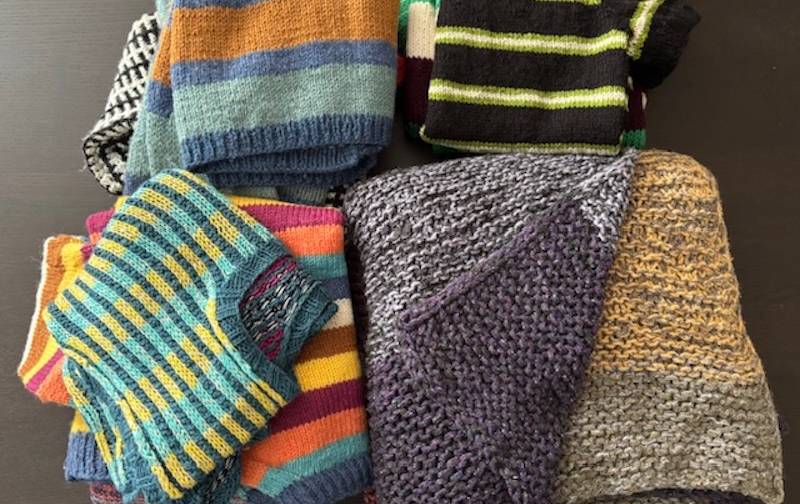

Stripes are an unabashed favorite. Reasons why:
1. Stripes are a container for creativity that can shapeshift to suit your mood and materials. They can be fairly mindless relaxing projects that don’t require much attention, or exciting experiments in form, color, pattern, and more that require more planning.
The mathematical part of art—color, rhythm, movement, proximate relation, basically everything—emerges as a site of play and exploration with stripes.
2. Stripes are one of the best forms of colorwork. They have colorwork’s inherent “just one more row” addictiveness, but are relatively simple to manage and memorize. You don’t have to consult a chart as you go.
3. Stripes function as a built-in row counter. Rather than having to stop and measure every so often, once you know your stripe pattern and row gauge, you can do some quick math, figure out the repeats needed for the length you desire, and boom, you’re off.
4. They can be simple or complex, with endless variation. Vertical stripes? Horizontal stripes? How about both? Two colors? Three? Five? Twelve?
Small changes, like the numbers of colors used, the relative width of the stripes, the order, and the repetition can affect the aesthetic, rhythm, color story, and vibe.
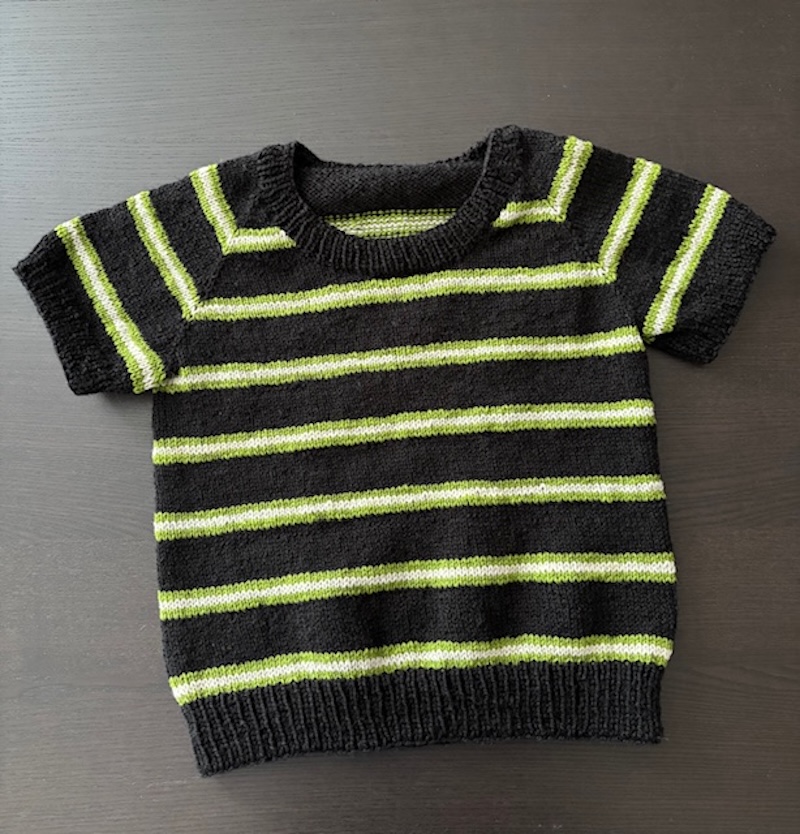
Kinsan by Sachiko and Kiyomi Burgin
My short-sleeved version of the Kinsan sweater, from twin designers Sachiko and Kiyomi Burgin, features three colors in an easy-to-remember pattern of 12 rows of black, followed by 6 rows (2 each) of green, silver, and green again. This is one of 11 stripe variations Sachiko and Kiyomi provide in their book Moon and Turtle: Knitting Patterns with Variations. Each strikes a different mood, with millions more possibilities.
The mathematical part of art—color, rhythm, movement, proximate relation, basically everything—really emerges as a site of play and exploration with stripes.
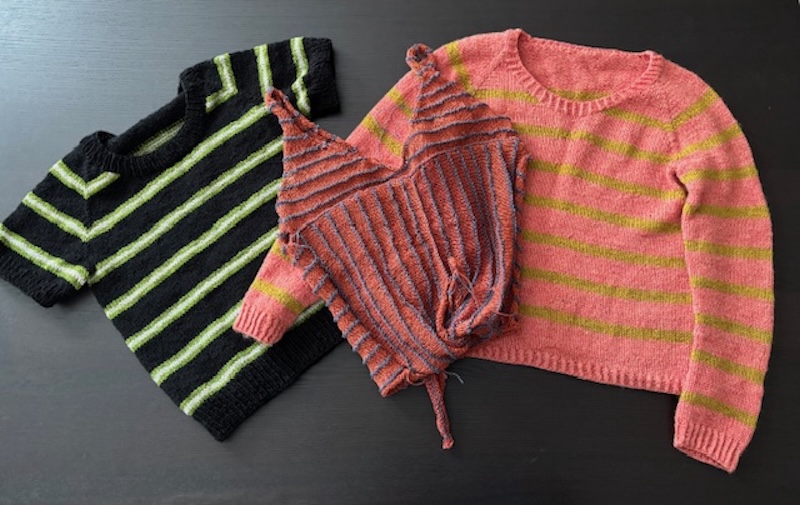
2025 stripes: Kinsan sweater by Sachiko and Kiyomi Burgin, Argil tank by Clare Lakewood, and Clarke sweater by Jane Richmond. Weaving in ends (and a little seaming!) remain on Argil.
5. Stripes are easy to use to modify patterns and change up the feel of a solid design or a design with other colorwork. I added stripes to the originally solid Warm Up sweater by Espace Tricot (pictured below) by knitting three colors in 14-row increments, for a sportier feel.
6. Stripes are relatively easy to pick up and put down. As someone who works on multiple projects at once, and has periods of active knitting and no knitting, I consider this a major plus. None of the striped garments I’ve finished this year were started in 2025 (I cast on Argil and Clarke in 2023 and Kinsan in 2024). Stripes are happy to hibernate.
7. Last but definitely not least, stripes can be a major stash buster. They are equally useful for yarns that you have small leftovers of and don’t know what to do with, and yarns you have too much of and don’t know what to do with.
Stripes helped me utilize a beautiful but lone two skeins of white, farm-fresh, fingering weight cormo I purchased as an overwhelmed fiber fest newbie. Held double, the white cormo balanced out colors for two striped sweaters knit at different gauges: a 7-color Aros sweater (DK), and my tricolor Warm Up sweater (aran).
Stripes also made practical use of a wool-free bulky weight yarn I once bought on sale in too many colors and quantities. Held double and marled, the yarn became a Garter Squish blanket pattern by Stephen West.
In each instance, what at first seemed to be stash fails turned into well-loved and useful items.

Stash-busting with stripes with the Warm Up sweater by Espace Tricot, Aros sweater by PetiteKnit, and Garter Squish Blanket by Stephen West.
Some of my most comfortable—and, not that it matters, but also most complimented—knits have stripes.
Most comfortable (and complimented): Diesis by Alice Caetano, Coven Cardi by Shay Johnson, and Bayadere by Lori Versaci
Stripes afford maximal impact with minimal materials, making the most of your stash and wallet. Through stripes, I’ve learned about gauge, fiber, color, and really getting to know and appreciate the material and utilizing it to its strengths, whether you have a little or a lot. Stripes provide a way to tap into creativity within constraint, which is, I think, central to creating.
Stripes do require some care and finishing. Jogless stripes, or making stripes to avoid the uneven “jog” that happens at the start of a new row, add that special touch of finesse. Patty Lyons has suggestions. One that’s worked well for me is knitting the first stitch of the second row with the stitch in the row below.
And weaving in ends, a much-lamented task among knitters, generally comes with stripe territory, unless you’re carrying the yarn as you go (which I do where possible).
However, ends aren’t always avoidable—and that’s OK. I find weaving in ends to be meditative. It allows me to shift gears, slow down, and wind down the knit—and the self I was with it, actively creating, experimenting, or resting. (That said, sometimes it works to leave a few ends out, too!)
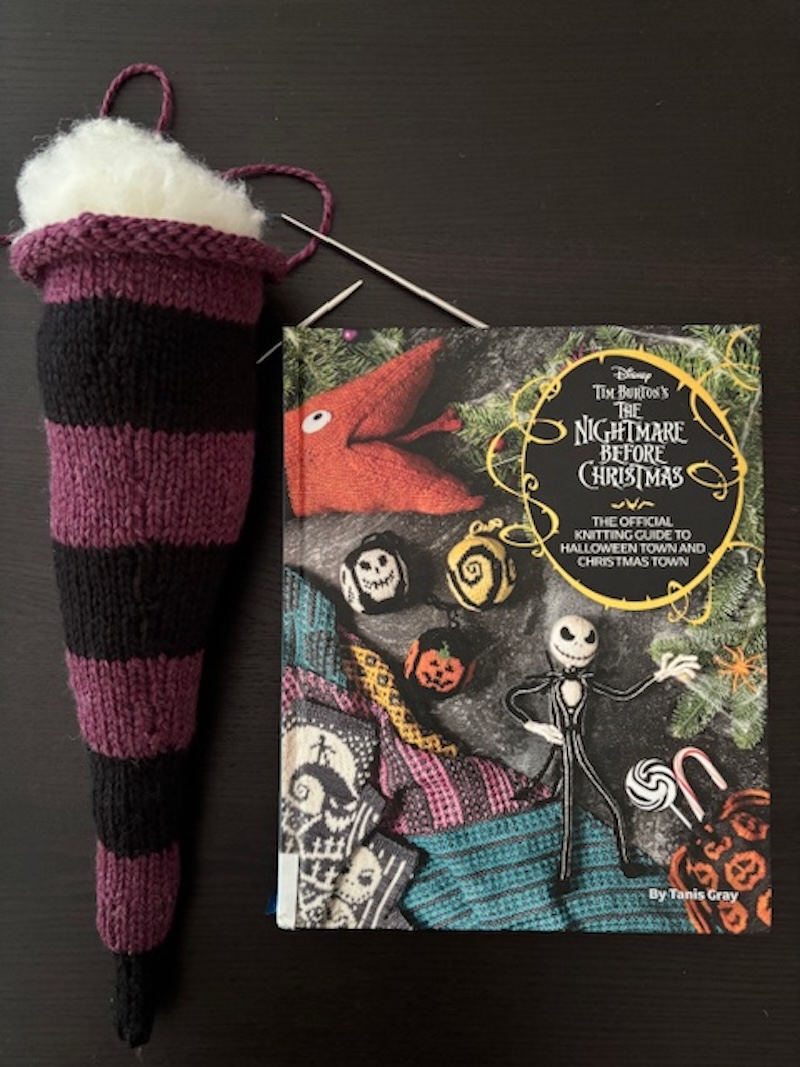
Snake Draft Blocker by Tanis Gray, using wool and waste yarn from other stripes for stuffing
My stripe project of the moment is a humorous, fun, and practical pattern: the Snake Draft Blocker by Tanis Gray from her Nightmare Before Christmas book.
It’s a low-stakes, low-stress project; a tongue-in-cheek design that references two of my favorite movies and makes me smile whenever I see it—the snake in The Nightmare Before Christmas is an Easter egg of the sandworms from Tim Burton’s earlier film Beetlejuice. It is seasonally appropriate as we approach Halloween and it promises to carry into winter some of that mischievous spirit that can be easy to lose sight of once we’re past October.
And it is a yarn and natural wool fiber-fill stash buster that’s also using ends of waste yarn from previous striped projects for stuffing. Stripes for the win.

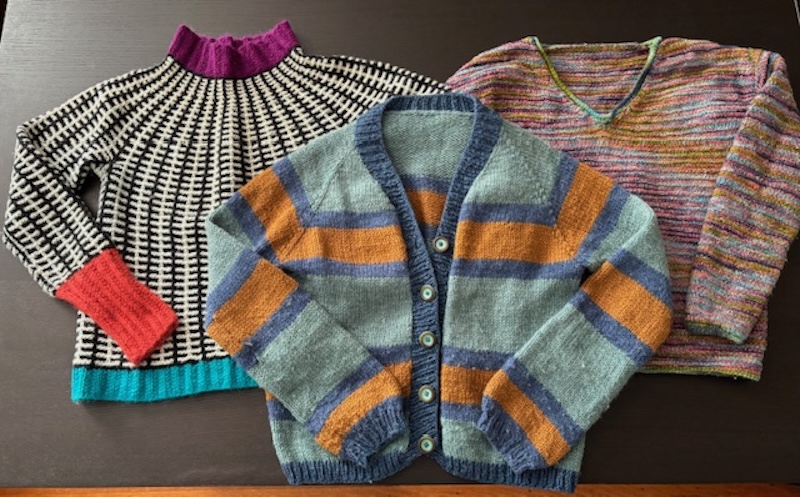

I love stripes…it breaks up the boredom.
Agreed!
SO inspiring!! At risk of casting on multiple new wips. Thank you for this terrific post.
Thank you, Wrighax!
Thank you, Jeanie. I’m fascinated by the stripes running both directions in the lower left sweater in the header. What is the pattern?
Interested too in the pattern name for the sweater showcasing vertical stripes with lime and bright blue horizontal stripes. Please share pattern and designer. Thank you for the inspiring article
Hi Chris – it’s the Anni tee by Gina Röckenwagner. A great pattern with stripes running in both directions and very fun to make and wear! https://www.ravelry.com/patterns/library/anni-5
Oops. I see. Thank you
Don’t forget the MDK field guide of Stripes….and also the Master Class one with Kaffes Garter Stripe wrap. Stripes are so fun!
Great recommendations! I love that stripes made MDK Field Guide No. 1!
Inspirational!
Thanks, Ramona!
Right there with you – love, love, love the stripes! Thank you for showing new-to-me patterns — already queued a few 🙂
Glad to add to the stripe love, Jenn!
Completely agree with you, Jeanie. Stripes are gauge checkers, row counters, colorful, uplifting, addicting, stash-busting, downright fun! Love your creativity on those projects.
Sorry – typed Jeania, but the text correct changed it to Jeanie!
Thank you, KarenG, and no worries!
Although I do not wear a lot of stripes, I LOVE knitting stripes. My daughter has a non-profit for which we knit warm hats for those in need in our area (MN – we need a lot of hats!) and some of my favorite hats that I have knit are striped. So much fun. AND – easy to carry the yarn on the inside of a hat knit in the round.
Oh! I don’t think I’ve done a striped hat yet. Will have to add that to the list!
I also love knitting stripped hats! They are fun, not only breaking up the monotony but look so great when knit up.
Thank you for a lovely article. I enjoy stripes and playing with them while stashbusting. “The mathematical part of art—color, rhythm, movement, proximate relation, basically everything—emerges as a site of play and exploration with stripes.”
I never think of art as being mathematical, this is great!
Thanks, Mlegan!
Love the use-up-your-stash concept. Let the stash decide what to knit? I will have to think about gauge based on the yarn types and do a lovely multi colored creation for the love of free-style. In my youth in Denmark, we knitted “hønsestrik” (chickenknits) that were freeflowing colorful patterns, kind of like fair isle. I’m thinking I need to do more of that to get myself out of the perfect-good-girl-follow-the-pattern rut.
I can relate, Helene. Sometimes it’s hard to break out of the structured routine. Your freeflowing knitting experiences of years past sound amazing – what a great tradition to be able to draw on for inspiration today.
That sounds interesting, I am off to see if I can find any pictures.
I love your ode to stripes but I know my limits (despite my yearning for Stripe Hype), so I turn to self-striping yarns which also have room for creativity. And thanks for reminding me of Stephen West’s blanket pattern. Marling forever!
Chloe, this is great – and (funny enough) I think I actually have never made anything with self-striping yarn yet! I do have some self-striping skeins lined up for a hat or socks … you may have just encouraged me to cast it on sooner than later, to see how the experience compares to striping with individual colors. Thank you!
Thanks Jeania, perfect timing for me. I have the yarn for a new sweater that will have stripes but I have not quite come up with the order. The Kinsan sweater’s 3 colour sequence is shouting “Pick me! Pick me!” so I am going to get swatching.
Thanks a bunch.
I’m so glad, Margo. Happy swatching!
This is just catnip, truly. You’re giving me the most massive stripe craving–your knits are so varied and interesting to see as a collection. I love seeing where your taste leads you, Jeania!
Thanks, Ann! It’s funny when you step back and realize that you have a “set” of something when you’ve just been plugging away one by one. All of my striped projects have such different, particularized making experiences and histories (as all our projects do), but it’s kind of nice to realize a coherence across them.
This is truly stash inspiration!!! And thanks for sharing that some of your sweaters finished this year were not started this year!!! Inspiring!!!
Thank you, Deneise! And most definitely re: timeline — some of my projects take a good, long hibernating nap (or several) as they’re coming along and I’m totally fine with that 🙂
I loved the post. We all have lots of single skein stash and you’ve made some wonderful suggestions for good use. Thank you and best wishes on your doctoral pursuit. Proud of you my sistah.
Glad to assist with some ideas, Ida! And thanks 🙂
Looking forward to receiving news
I was recently inspired by a striped blanket I’m thinking of trying – here’s my nudge! Thanks for sharing 🙂
That sounds like a fun project, Kadija! Happy to encourage you as well!
Wonderful…thank you for this. I will print it to enjoy it now and the…. Birgit
I love everything you’ve knitted here and just loaded my Ravelry favorites list with your choices!
A fun read. Encouraging me to look at my stash in a different and fun way. Thank you
Gorgeous, vibrant work! What a tasty snack for those of us whose brains love the rhythm and colors of stripes! Choosing color combos brings me such design joy. Thanks so much for the showcase and sharing the patterns. I’ve added Anni and Diesis to my queue, woot!
Great article! I’m currently finishing knitted striped pullover sweaters in five colours for my grandkids. After my Christmas gift knitting – washcloths, dishcloths, a dog sweater, and a cat sweater – I want to knit myself a striped cardigan from my yarn stash. Thanks for the fun read!
Thank you for reminding me how much I love stripes! And that I might need to plan some stripey goodness for the near future…!
Stripes are my favorite color!!